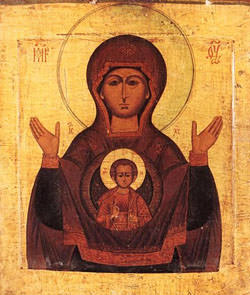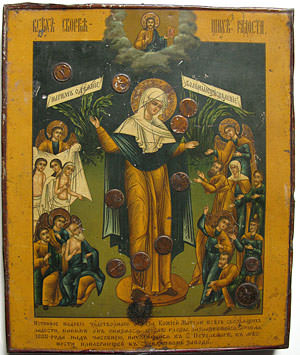Like the icon of Christ, that of the Mother of God (Theokotos) is considered authentic, an object of worship, because it is a revealed truth. Tradition identifies the first portretist of the Virgin and Child as the evangelist Saint Luke, even though he did not meet Mary until after Christ's death when she was already elderly.
"Painting your image most worthy of honor, Saint Luke, author of the Gospel of Christ, inspired by the voice of God, depicted the Creator of all things in your arms" (Troparion for the feast of the Vladimir Mother of God icon).
![]()
With some exceptions, most of the Russian Orthodox icons depicting the Most Holy Mother of God (Theotokos) can be divided into four broad groups: The Eleusa (The Tenderness), The Odigitria (The Guide), The Oranta (The Sign) and The Akathist (The Hymn).
![]()
![]()
![]()
![]()
1. The Virgin of Hodegetria icon (Russian: Одигитрия - Путеводительница) Hodegetria is translated from Greek as "The Guide" or "She who shows the way". This type is the most ancient type with the first icon attributed to the Evangelist St. Luke.
“The truthful way as a way to Jesus” statement indicated by a gesture of the Virgin’s right hand. She touches and points to the Child, who is positioned on the left hand holding a manuscript of the Law.
Some examples of this type of icon are:
* Kazan icon of the Mother of God (Казанская) *
![]()
![]()
![]()
* Valaam icon of the Mother of God (Валаамская) *
![]()
![]()
![]()
* Smolensk icon of the Mother of God (Смоленская) *
![]()
![]()
![]()
* Iverskaya (Iversk) icon of the Mother of God (Иверская) *
![]()
![]()
![]()
* Gruzinskaya (Georgian) icon of the Mother of God (Грузинская) *
![]()
![]()
![]()
* Tikhvin icon of the Mother of God (Тихвинская) *
![]()
![]()
![]()
* Quench My Sorrows icon of the Mother of God (Утоли моя печали) *
![]()
![]()
![]()
* Three-Handed Madonna icon (Троеручница) *
![]()
![]()
![]()
* Icon of Ozernaya Mother of God (Озёрная) *
![]()
![]()
![]()
* Jerusalem icon of the Mother of God (Иерусалимская) *
![]()
![]()
![]()
* Madonna of Unexpected Joy (Нечаянная радость) *
![]()
![]()
![]()
The division of the Mother of God iconography on four major types is very generic and serves only as a guide. In addition, we can separate Panachranta or All-Forgiving (Всемилостивая) a depiction of the Mother of God as aHeaven's Queen Enthroned with Christ child on her lap.
![]()
![]()
![]()
![]()
![]()
2. The Virgin of Eleousa icon (or Eleousa) (Greek: Ἐλεούσα — Tenderness or Showing Mercy, Russian: Елеуса - Умиление или Милующая) is a variant of the more ancient and solemn Hodegetrea and expresses the intencity of the loving and affectionate relationship between the Mother and the Christ child. The Virgin Mary depicted with the infant Jesus Christ nestled against her cheek. Nary hugs Jesus close to her, their faces no longer frozen and frontal, but turned toward one another, cheeks touching as the Son grabs her cloak.
The Elousa spread through Byzantium and Russian in the XII century. The most famous example of it is the Vladimir icon of the Mother of God (Vladimirskaya, Владимирская икона Божией Матери), originally painted in Constantinopol and brought to Kiev in 1130. After conquering the city in 1160, Prince Andrey Bogolubsky too the icon to Vladimir, the city whose name it eventually took. In 1395, the icon was brought in procession to Moscow to protect the city from Mongol's hordes. The icon became a symbol of the struggle against the invading Mongols.
![]()
Some other examples of this type of icon are:
* Fyodorovskaya icon of the Mother of God (Фёдоровская икона Божией Матери) *
![]()
* Donskaja icon of the Mother of God (Донская икона Божией Матери) *
![]()
* Tolgskaya icon of the Mother of God (Толгская икона Божией Матери) *
![]()
![]()
![]()
![]()
![]()
3. The Virgin of Orans, Oranta icon (Russian: Оранта - Молящаяся). In this type, the Virgin Mary is depicted in prayer with extended arms and the palms of her hands turned heavenward. Over hear heart appears an image of Christ Emmanuel.
The full-lengh depiction with the Child are called "Great Panagia" or "The All-Holy" (Всесвятая). The half-lengh depictions of the "Great Panagia" type are popular in the Russian iconography under the name "The Sign" (Знамение). The iconogical typography is derived from the prophecy of Isaiah (7:14) "Therefore the Lord himself will give you a sign: The virgin will conceive and give birth to a son, and will call him Immanuel."
![]()
In Russia, the image of the Virgin of Orans spread to Kiev in the XII century and later to Yaroslavl.
Some examples of this type of icon are:
* Novgorod icon of the Mother of God of the Sign (Икона Божией Матери "Знамение" Новгородская)*

![]()
![]()
* The Unbreakable Wall icon of the Mother of God (Икона Божией Матери "Нерушимая Стена") *
![]()
![]()
![]()
* Life-Giving Source Madonna (Wellspring Madonna) icon (Икона Божией Матери "Неупиваемая Чаша") *
![]()
![]()
![]()
![]()
![]()
4. The Virgin of Akathist (Greek: Ἀκάθιστος, Russian: Акафистная) is a type of icons which are painted specifically for the veneration of the Virgin Mary and most frequently depcit the Virgin Mary without the Child. According to the Eastern tradition, such full lengh depictions of the Virgin Mary without the Child are placed in the upper part of the Orthodox Altar.
Some examples of this type of icon are:
* Joy of All who Sorrow (Всех Скорбящих радость) *
![]()
![]()
![]()
* Madonna of Joy of All Who Sorrow with Coins *

![]()
![]()
* The Virgin of Bogolubovo (Боголюбовская Богоматерь) *
![]()
![]()
![]()
* The Protecting Veil of the Virgin (Покров Пресвятой Богородицы ) *
![]()
![]()
![]()
* Seven Arrows Mother of God icon (Семистрельная Богородица)*
![]()
![]()
![]()
* Akhtir Mother of God icon (Ахтырская Богородица) *
![]()
![]()
![]()
![]()
![]()




 Change language to English
Change language to English